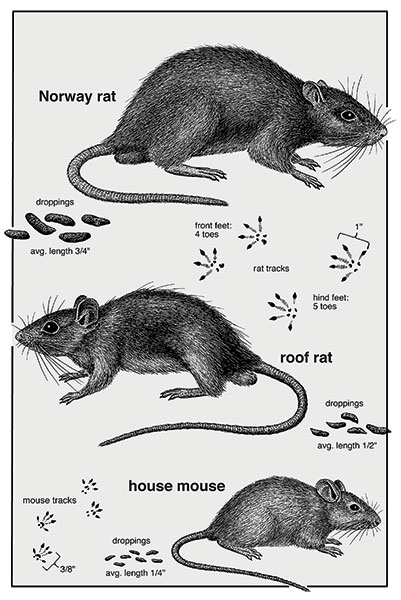Author’s Note: Information is taken from Truman’s Scientific Guide to Pest Management Operations, which is available at the PMP Bookstore.
Chapter 17 of the Truman’s Guide is titled “Rats and Mice” — and focuses mostly on three commensal rodents in the family Muridae: house mice (Mus musculus); Norway/brown rats (Rattus norvegicus), and roof/black rats (R. rattus). However, the chapter also covers such varied species as deer mice (Peromyscus maniculatus), white-footed mice (P. leucopus), and meadow mice (Microtus spp., also known as voles). Biology, behavior and suggested treatment measures are all included.
Also included are the myriad rodent-transmitted diseases and health issues of most concern in today’s world, such as typhoid and dysentery. Use this list to let your customers know what having rodent-free premises really means in terms of public health:
- Mouse allergens: The house mouse carries a protein in its urine that can trigger severe cases of asthma and allergic rhinitis in susceptible people. Considering that mice typically urinate in microdroplets as they forage inside a room, literally thousands of microareas on surfaces can be covered with mouse urine inside infested homes, schools, offices, etc.
- Hantavirus: The deer mouse has been identified as an important reservoir of the potentially deadly hantavirus pulmonary syndrome (HPS), although the cotton rat (Sigmodon hispidus) and white-footed mouse also have been implicated with similar hantaviruses. The Norway rat is associated with hantavirus strains that cause hemorrhagic fever and renal failures.
- Flea- and mite-borne disease: While the most commonly known disease that stems from flea to rat to person is sylvatic plague, it’s not thought to exist in commensal rodents in the United States. It is, however, found in ground squirrels (Marmotini) and prairie dogs (Cynomys spp.) in certain areas. Murine typhus can be transmitted from rats infected by the tropical or Oriental rat flea (Xenopsylla cheopis) or, in some cases, the cat flea (Ctenocephalides felis). In addition, rickettsialpox can be transmitted by mites to house mice — and thus to people — in densely populated areas.
- Foodborne illness: Two of the most commonly rodent-transmitted bacterial diseases leading to food poisoning are salmonellosis and campylobacteriosis. Both campylobacter and salmonella thrive on decaying food, on poultry and meats, and in sewers, livestock facilities, septic tanks, cesspools, accumulated garbage and other unsanitary environments. Because rodents frequent these areas and then visit homes and food facilities, the potential for transmitting diseases via their feces increases.
- Rat-bite fever: Caused by the bacterium Streptobacillus moniliformis, this fever responds quickly to antibiotics. As a result, it is thought to be underreported in the United States because it’s written off as a case of the flu. In some cases, it’s transmitted when someone tries to handle a glue board that is incorrectly thought to have a “dead” mouse — the mouse makes a last-ditch defense bite.
- Weil’s disease (leptospirosis): Caused by a spirochete bacterium of the genus Leptospira, this usually is transmitted by rats to dogs, cattle or pigs. These animals, in turn, can transmit the organism to people. Rats also can transmit it directly to people. The disease is spread via rat urine into the water or food of domestic animals or people.
- Lymphocytic choriomeningitis (LCM): For several years running, this virus has been identified in wild house mice in several U.S. cities.
- Trichinosis: Caused by the trichina worm, this disease can be harbored and shed by rats via their feces into hog feed. People then acquire trichinosis by eating improperly cooked pork from contaminated hogs.
Rodents in the news
Newly released data from the U.S. Census Bureau reveals Philadelphia, Boston and New York are the Top 3 rodent-infested cities in the United States. See who else made the cut — as well as the top cockroach-infested towns — as reported by Bloomberg News.

Leave A Comment